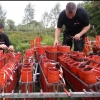I'm not yet in a position to mill good quality BP for reliable lift powder and as I'm only experimenting with small star shells (circa 1 inch od tubes) and 2 inch mines, I've been trying Benzolift as an alternative. I appreciate it contains whistle so am wet mixing both the oxidisers before the fuels so I never have dry whistle mix making it this way.
So I've done some very small scale testing today and have tested in a 1 inch cardboard tube firing a 30g dummy star shell. Also tested with a 3/4 inch tube firing a 10g dummy.
I started on the 1 inch tube and used 2.5g of Benzolift which was a fairly fine powder (I powdered it as it was a bit granular from when I made it) and was what I thought I'd have used if I was using a really good BP. This did a pretty good job on the tube and blew it to bits
I later tried 1g of exactly the same Benzolift comp with the same 1 inch tube but this batch was granulated via a 20 mesh. This worked much better indeed and I lost my dummy shell in some bushes.
I did a few more tests on smaller tubes etc and I noticed that Benzolift seems VERY sensitive to pressure and if you dare to contain it in the slightest it just destroys the tubes even nice thick walled ones. Can anyone suggest whether granulating will have a beneficial affect with regard to controlling its tendency to do this? Or do I simply need to make sure I don't contain it too much with tight fitting shells and make sure I get my quantities spot on?
Also...
I want to make small shells using cardboard tubes and I know commercial manufacturers do this a lot for small to large cakes. I've been making some very small cut stars and rolled them in prime. I'll plug one end with clay and glue the other and use some good visco for timing them. To break them I was going to use a simple flash e.g Potassium Perchlorate and Aluminium (Dark) as I've read this is how they do it in commercial shells of this size. My question is: Is this going to be too powerful and just blow them blind or even just destroy the stars? Is there a way to make the composition hotter and slower by simply increasing the amount of fuel? Or maybe using a larger mesh Alu? Was intending on testing with 1g of flash to start.















